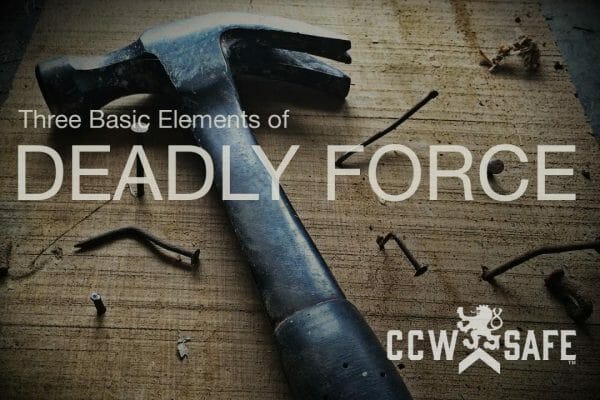
U.S.A. –-(Ammoland.com)- There is an old saying that goes something like this: “If all you have is a hammer, everything looks like a nail.” I am aware of multiple individuals that found themselves behind bars as a result of threatening another with a handgun when an excellent option at the time was to simply walk or drive away. More than a few well-intentioned persons ended being criminally charged when they thought that their lawfully-carried handgun was some sort of 21st century magic talisman that could be used to extricate them from a situation that could have been handled differently up to a point. In Texas, a person commits a Class B Misdemeanor if he threatens to commit any violence to another person with the intent to place that person in fear of imminent bodily danger without good cause (Texas Penal Code 22.07 Terroristic Threat). In some states, improper brandishing of a firearm may be deemed Aggravated Assault.
I would encourage readers to know their state’s laws regarding the use of deadly force. We typically tell our students that at a minimum there are three basic elements to consider:
- Ability: Does the person have the actual physical means to seriously injure or kill me? This could include possession of weapons, size and strength of the attacker, known or apparent skills possessed by the attacker, or number of attackers.
- Opportunity: Is the person close enough or otherwise in a position to utilize any such abilities? What is the distance involved and are there barriers or other impediments that would make it difficult for him to harm or kill me? Could I have left the scene immediately and eliminated that opportunity?
- Intent: Is the person manifesting a reasonably obvious desire to harm or kill me, or otherwise given me reason to believe that to be true?
If I can check all three boxes, and disengagement (drive away, walk or run away, or roll up my windows and lock my doors in my car) is simply not possible, then and only then do I consider resorting to my handgun, but only if a less-lethal form of defense is not an option.
One problem is that persons who are angry often show it by yelling, cursing, adopting aggressive posture, and sometimes even threatening physical violence. The problem is that it does not necessarily mean they intend to attack us, and we may find we are checking off the intent box a little too early. My concern now lies with ability and opportunity, and in no way do I wish to discount the fact that sometimes people have weapons concealed on their body or that they may actually be capable of great violence using their hands and feet. However, is it likely that I am going to need to draw a gun to save my life if I first avoided a confrontation, or disengaged as soon as the opportunity presented itself? If I am in a parked car and unable to drive away because of traffic, how much actual danger am I in from another person who is not visibly armed with a gun if my windows are rolled up and doors are locked? I would be most unhappy if Mr. Road Rage damages my car by kicking it or tries to break a window, but the reality is that my family has had vehicles vandalized on multiple occasions, and once we dealt with insurance and got the damage repaired, we mostly just forgot about it and our lives have been fine since.
It is important to check the ego. If we have to have a handgun on our person in order to more safely deal with an inconsiderate neighbor and are compelled to threaten to draw it or actually draw it, our best-case scenario may be that we have to deal with the legal system thereafter.
Here is a lesson for those that carry a concealed handgun and wish to avoid trouble. If it is not safe to do something or go somewhere without a handgun, it is not safe to do something or go somewhere with a handgun. The concealed carrier is almost without a doubt going to have to justify why his or her handgun came into play, even if it never actually left the holster.
Does that mean that there is never cause to draw a handgun? Absolutely not, but it is important to know when it is the right time to lawfully defend ourselves. Training helps.
About the Author: STEVE MOSES
Steve is a long-time defensive weapons and instructor based out of Texas who has trained hundreds of men and women of all ages for more than two decades on how to better prepare to defend themselves and their loved ones. Steve has completed over 80 private-sector and law enforcement-only defensive weapons and tactics classes, and has trained civilian and law-enforcement officers in six states. Moses is a reserve deputy, former member of a multi-precinct Special Response Team, competitive shooter, and martial artist. Steve has written numerous articles for SWAT Magazine and other publications. Steve is a licensed Texas Level 4 Personal Security Officer and Instructor who was Shift Lead on a mega-church security detail for seven years, and has provided close protection for several former foreign Heads of State. He is currently an instructor at Relson Gracie Jiu Jitsu/Krav Maga in Tyler, Texas and Director of Training for Palisade Training Group (www.ptgtrainingllc.com).
About CCW Safe, LLC:
Founded by former police officers and attorneys who have all worked on local, and federal levels of law enforcement, CCW Safe, LLC offers legal service membership plans for concealed-carry permit/license holders and law enforcement officers. Two of the founders, Mike Darter and Stan Campbell, have spent more than 20 years each in law enforcement and have been victim of federal lawsuits themselves from shooting and use of force incidents as police officers. General Counsel, Kyle Sweet, is a former police officer and current owner of Sweet Law Firm, representing hospitals and health care professional across the United States. With a strong membership base in 50 states, CCW Safe will have the most experienced attorneys in the jurisdiction of the incident handle members’ cases. Learn more on how to become a member at CCWSafe.Com.
